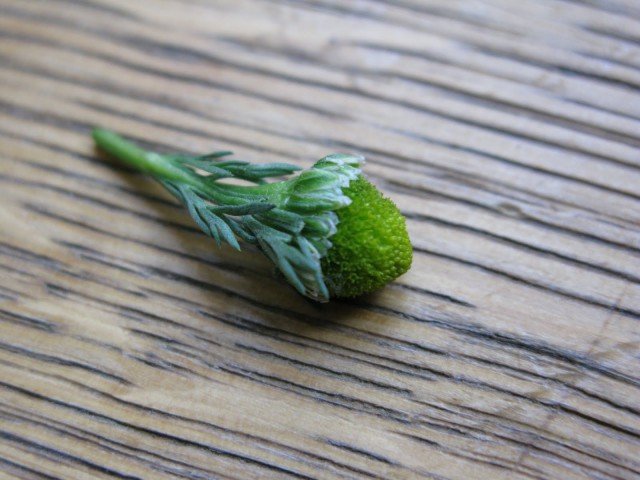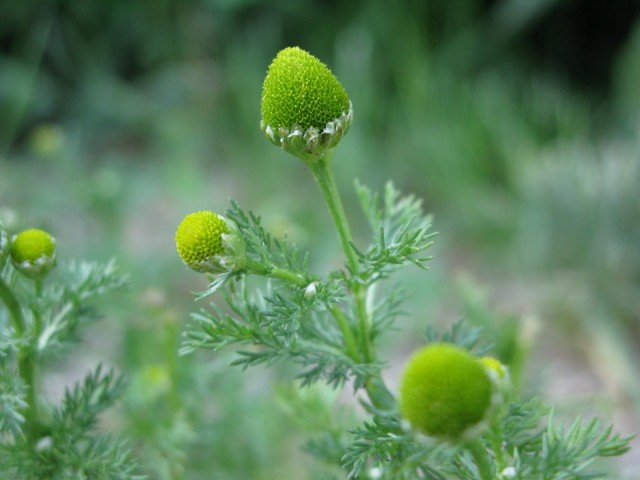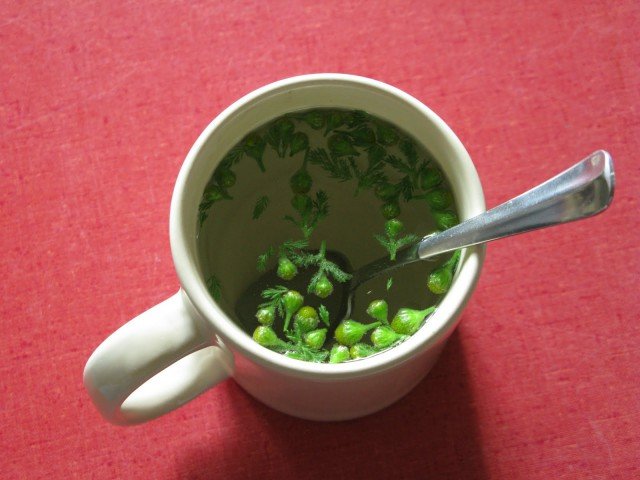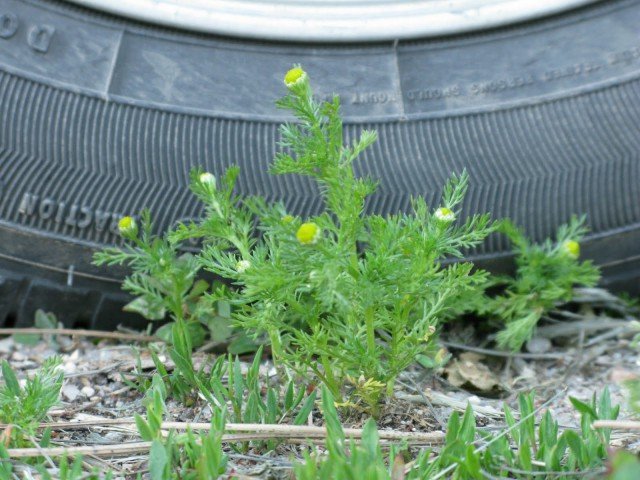Identifying and Using Pineapple Weed
- Sarah Spotten
Sarah is a Midwest Permaculture PDC Graduate.
Recently my mother-in-law, curious about a low-growing wild plant that she had observed around her horse barn, picked one of the small, petal-less flower heads and crushed it between her fingers to see what it smelled like. Fascinated that it gave off a very sweet and distinctive fragrance, she brought the flower to me and we put our heads together to identify the plant. I recognized this plant by sight, having seen it a lot growing up in Southern and Central California, but I didn’t know what it was or anything about it.

My first thought was that our little flower head reminded me of dried flower heads in loose chamomile tea, and that the fragrance – though far too sweet – was vaguely reminiscent of chamomile. My second thought (or hope, rather) was that our sweet, fragrant flower might make a good wildcrafted tea itself.
Characteristics we observed:
- Small weed growing close to the ground, no taller than 4 inches
- Yellow-green, cone-shaped flower heads without petals
- Reminiscent of chamomile
- Sweet smell when crushed
- Fine-textured, pinnate leaves
- Growing in compacted or rocky soils around buildings and especially driveways and areas where vehicles and tractors are parked – but not in disturbed areas completely surrounded by grasses and other weeds (in other words, we found it where humans have changed the soil the most with their structures and access roads)

After some Internet searching, I tentatively identified our mystery plant as Matricaria discoidea, more commonly known as “pineapple weed,” “wild chamomile,” or “disc mayweed.” One whiff of our little crushed flower confirmed it – ah yes, pineapple is what that sweet smell is! The plant is also listed in some texts as Matricaria matricarioides (for example, in Toby Hemenway’s book, Gaia’s Garden: A Guide to Home-Scale Permaculture).
Pineapple weed is native to many areas of northeast Asia and North America, including the state of Colorado, where I live and where my mother-in-law and I observed it growing. It is a hardy weed and grows in poor, compacted soils; thus, pineapple weed can be a good indicator of where the soil has been compacted or recently been disturbed. It thrives where there is not much competition from other indigenous plants, which is why so far I have not observed it growing very far away from where humans have previously cleared the land or continue to compact the soil with vehicles. The plant grows from 2 to 16 inches in height, and flowers from March through September.
Native Americans used Matricaria discoidea for a variety of medicinal and cultural purposes. Medicinal uses include treating gastrointestinal upset and gas, infected sores, fevers, menstrual pain and postpartum anemia. Many Native American nations also used pineapple weed as a perfume, insect repellant, preservative, jewelery, and in sun dance and sweat lodge ceremonies.
I was delighted to find out that pineapple weed is edible – and not only that, it makes a good herbal tea! According to several sources, one can make pineapple weed tea by steeping a small handful of young flower heads in hot water for 5 to 10 minutes. Following these directions, I made a cup of this tea myself, which tastes like a sweeter version of chamomile tea – delicious! One can also use the leaves or even whole plants to make tea, but from what I’ve read the leaves will give a slightly more bitter flavor to the finished tea.

Very pleasantly surprised by the (re)discovery of this herb, I plan on collecting seed from our wild pineapple weed patches and cultivating my own plants to make tea with.
Sources:
- Hemenway, Toby. Gaia’s Garden: A Guide to Home-Scale Permaculture, Second Edition, p142. White River Junction: Chelsea Green Publishing Company, 2009.
- Wikipedia: http://en.wikipedia.org/wiki/Pineappleweed
- 100-Garden-Articles.com: http://www.100-garden-articles.com/articles/A-Tea-Lovers-Soul-Weed.shtml
- Government of Manitoba: http://www.gov.mb.ca/agriculture/crops/weeds/fab39s00.html
- University of Michigan Native American Ethnobotany Database: http://herb.umd.umich.edu/herb/search.pl?searchstring=Matricaria+discoidea
![photo[1]](https://b2792463.smushcdn.com/2792463/wp-content/uploads/2012/06/photo1.jpg?lossy=0&strip=1&webp=1) Sarah Spotten currently lives in Colorado. Her current projects can be found at http://sarahspotten.com. Sarah Spotten currently lives in Colorado. Her current projects can be found at http://sarahspotten.com. |

